Why Did Life Move to Land? For the View
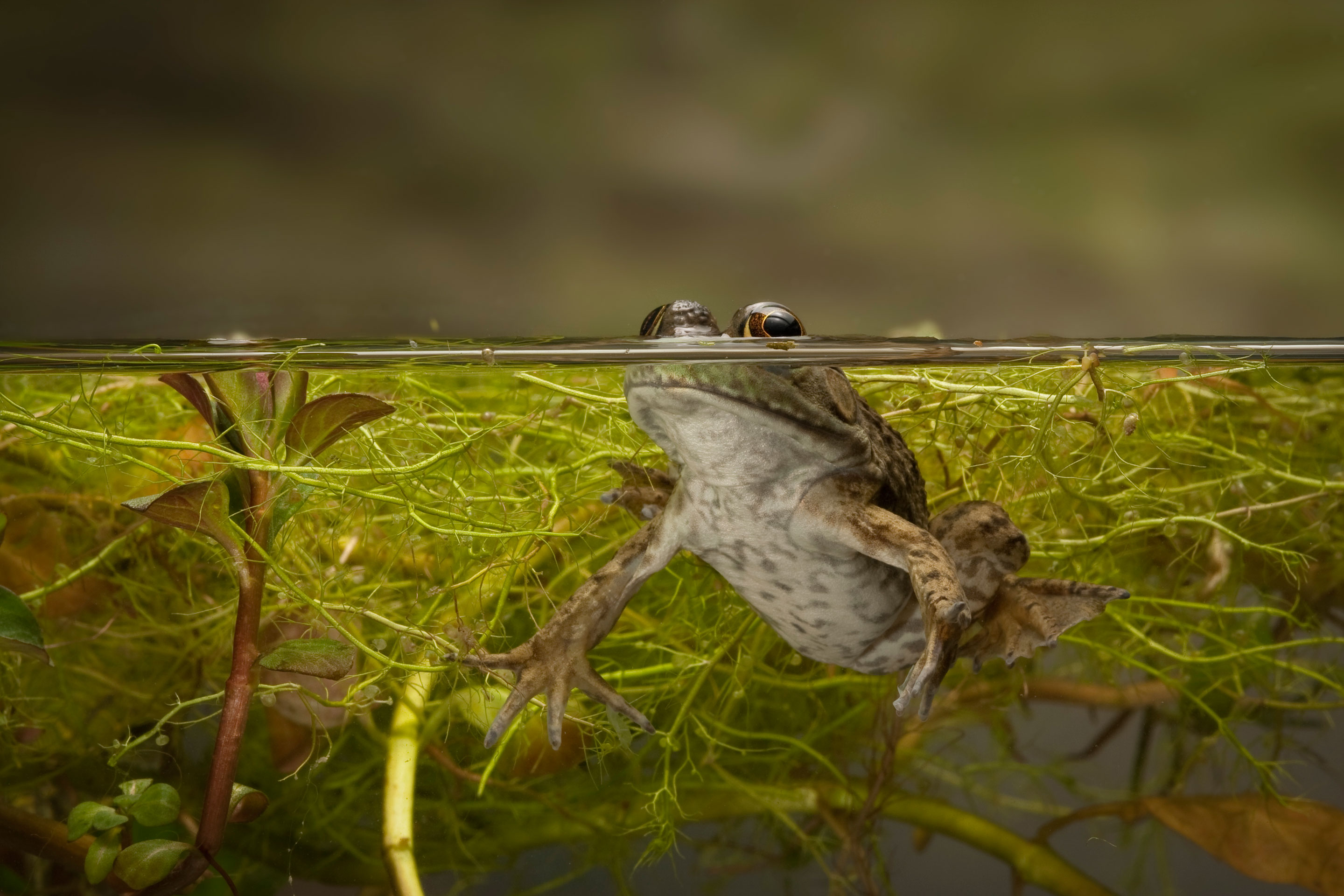
A juvenile Southern Leopard Frog (Rana sphenocephala) looks out of the water.
Introduction
Life on Earth began in the water. So when the first animals moved onto land, they had to trade their fins for limbs, and their gills for lungs, the better to adapt to their new terrestrial environment.
A new study, out today, suggests that the shift to lungs and limbs doesn’t tell the full story of these creatures’ transformation. As they emerged from the sea, they gained something perhaps more precious than oxygenated air: information. In air, eyes can see much farther than they can under water. The increased visual range provided an “informational zip line” that alerted the ancient animals to bountiful food sources near the shore, according to Malcolm MacIver, a neuroscientist and engineer at Northwestern University.
This zip line, MacIver maintains, drove the selection of rudimentary limbs, which allowed animals to make their first brief forays onto land. Furthermore, it may have had significant implications for the emergence of more advanced cognition and complex planning. “It’s hard to look past limbs and think that maybe information, which doesn’t fossilize well, is really what brought us onto land,” MacIver said.
MacIver and Lars Schmitz, a paleontologist at the Claremont Colleges, have created mathematical models that explore how the increase in information available to air-dwelling creatures would have manifested itself, over the eons, in an increase in eye size. They describe the experimental evidence they have amassed to support what they call the “buena vista” hypothesis in the Proceedings of the National Academy of Sciences.
MacIver’s work is already earning praise from experts in the field for its innovative and thorough approach. While paleontologists have long speculated about eye size in fossils and what that can tell us about an animal’s vision, “this takes it a step further,” said John Hutchinson of the Royal Veterinary College in the U.K. “It isn’t just telling stories based on qualitative observations; it’s testing assumptions and tracking big changes quantitatively over macro-evolutionary time.”
Underwater Hunters
MacIver first came up with his hypothesis in 2007 while studying the black ghost knifefish of South America — an electric fish that hunts at night by generating electrical currents in the water to sense its environment. MacIver compares the effect to a kind of radar system. Being something of a polymath, with interests and experience in robotics and mathematics in addition to biology, neuroscience and paleontology, MacIver built a robotic version of the knifefish, complete with an electrosensory system, to study its exotic sensing abilities and its unusually agile movement.
When MacIver compared the volume of space in which the knifefish can potentially detect water fleas, one of its favorite prey, with that of a fish that relies on vision to hunt the same prey, he found they were roughly the same. This was surprising. Because the knifefish must generate electricity to perceive the world — something that requires a lot of energy — he expected it would have a smaller sensory volume for prey compared to that of a vision-centric fish. At first he thought he had made a simple calculation error. But he soon discovered that the critical factor accounting for the unexpectedly small visual sensory space was the amount that water absorbs and scatters light. In fresh shallow water, for example, the “attenuation length” that light can travel before it is scattered or absorbed ranges from 10 centimeters to two meters. In air, light can travel between 25 to 100 kilometers, depending on how much moisture is in the air.
Because of this, aquatic creatures rarely gain much evolutionary benefit from an increase in eye size, and they have much to lose. Eyes are costly in evolutionary terms because they require so much energy to maintain; photoreceptor cells and neurons in the visual areas of the brain need a lot of oxygen to function. Therefore, any increase in eye size had better yield significant benefits to justify that extra energy. MacIver likens increasing eye size in the water to switching on high beams in the fog in an attempt to see farther ahead.
But once you take eyes out of the water and into air, a larger eye size leads to a proportionate increase in how far you can see.
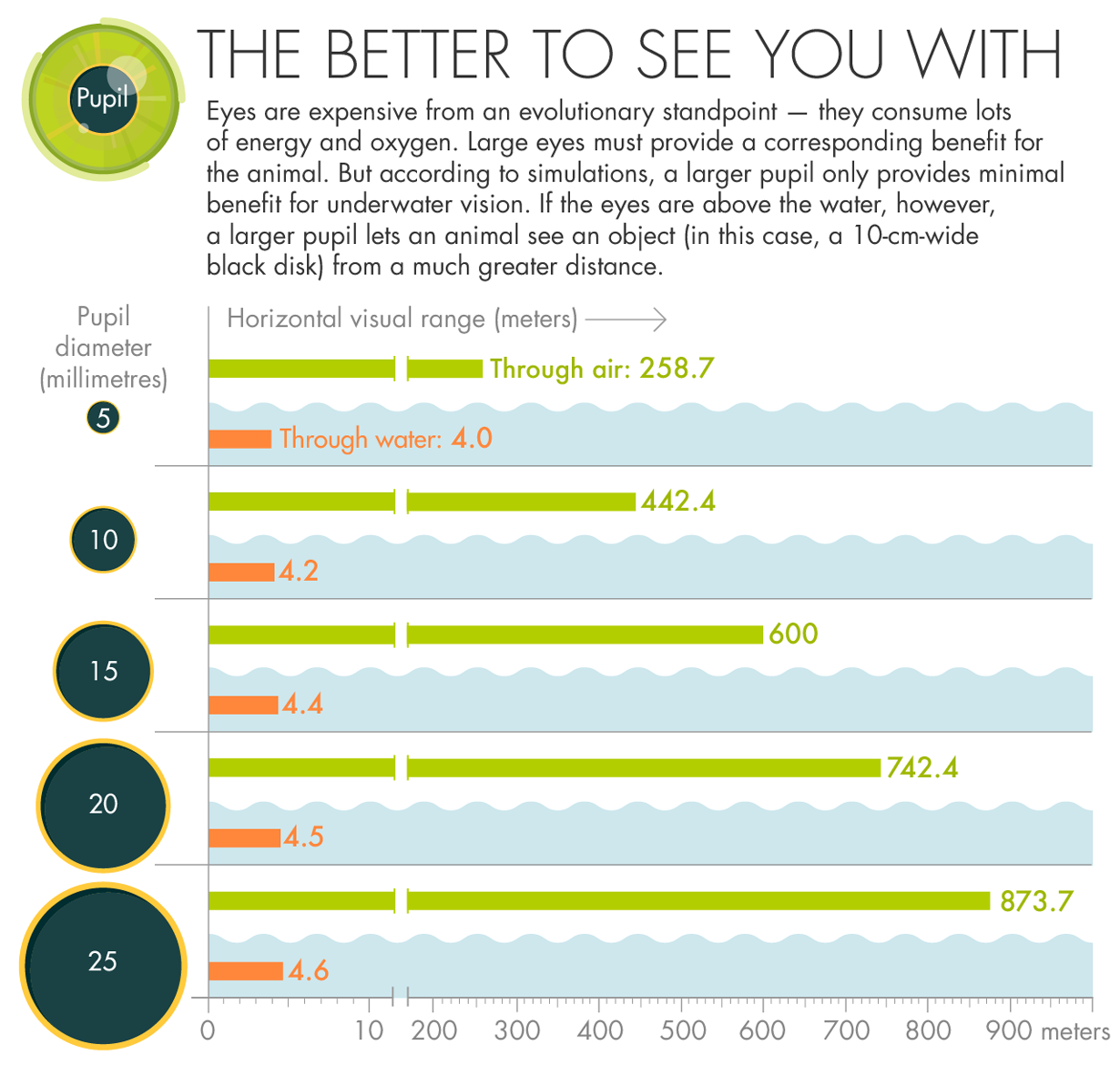
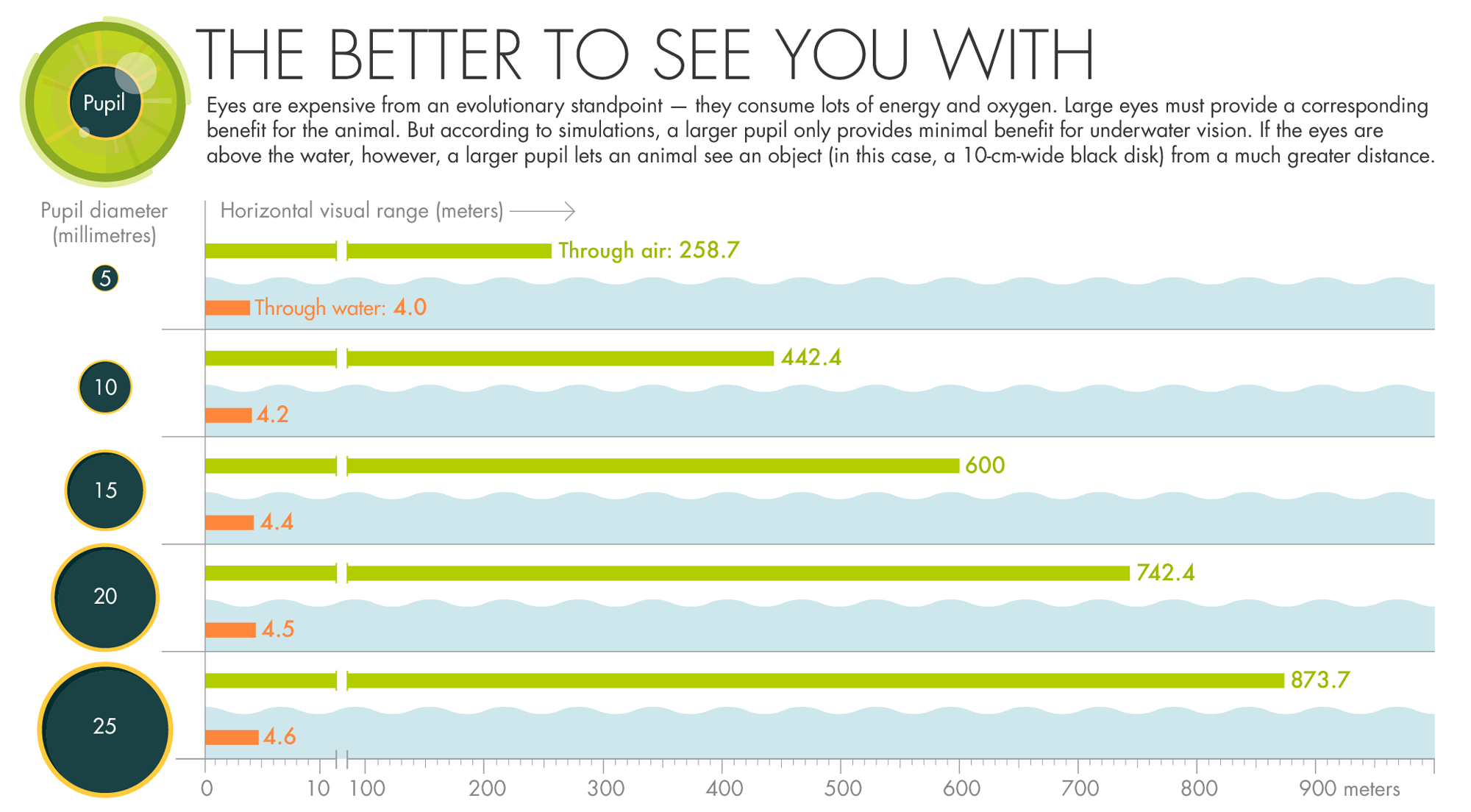
Lucy Reading-Ikkanda/Quanta Magazine
MacIver concluded that eye size would have increased significantly during the water-to-land transition. When he mentioned his insight to the evolutionary biologist Neil Shubin — a member of the team that discovered Tiktaalik roseae, an important transitional fossil from 375 million years ago that had lungs and gills — MacIver was encouraged to learn that paleontologists had noticed an increase in eye size in the fossil record. They just hadn’t ascribed much significance to the change. MacIver decided to investigate for himself.
Crocodile Eyes
MacIver had an intriguing hypothesis, but he needed evidence. He teamed up with Schmitz, who had expertise in interpreting the eye sockets of four-legged “tetrapod” fossils (of which Tiktaalik was one), and the two scientists pondered how best to test MacIver’s idea.
MacIver and Schmitz first made a careful review of the fossil record to track changes in the size of eye sockets, which would indicate corresponding changes in eyes, since they are proportional to socket size. The pair collected 59 early tetrapod skulls spanning the water-to-land transition period that were sufficiently intact to allow them to measure both the eye orbit and the length of the skull. Then they fed those data into a computer model to simulate how eye socket size changed over many generations, so as to gain a sense of the evolutionary genetic drift of that trait.
They found that there was indeed a marked increase in eye size — a tripling, in fact — during the transitional period. The average eye socket size before transition was 13 millimeters, compared to 36 millimeters after. Furthermore, in those creatures that went from water to land and back to the water — like the Mexican cave fish Astyanax mexicanus — the mean orbit size shrank back to 14 millimeters, nearly the same as it had been before.
There was just one problem with these results. Originally, MacIver had assumed that the increase occurred after animals became fully terrestrial, since the evolutionary benefits of being able to see farther on land would have led to the increase in eye socket size. But the shift occurred before the water-to-land transition was complete, even before creatures developed rudimentary digits on their fishlike appendages. So how could being on land have driven the gradual increase in eye socket size.
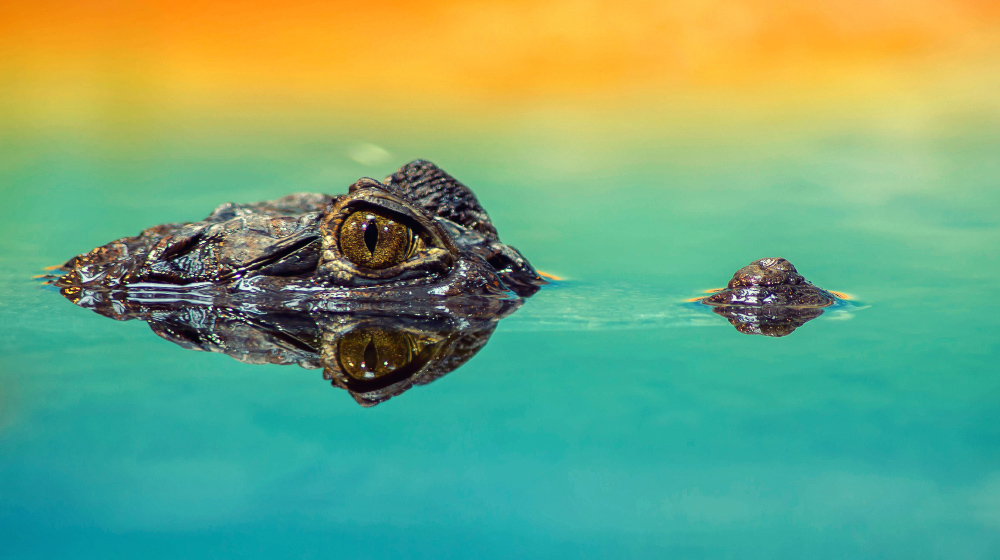
Early tetrapods probably hunted like crocodiles, waiting with eyes out of the water.
In that case, “it looks like hunting like a crocodile was the gateway drug to terrestriality,” MacIver said. “Just as data comes before action, coming up on land was likely about how the huge gain in visual performance from poking eyes above the water to see an unexploited source of prey gradually selected for limbs.”
This insight is consistent with the work of Jennifer Clack, a paleontologist at the University of Cambridge, on a fossil known as Pederpes finneyae, which had the oldest known foot for walking on land, yet was not a truly terrestrial creature. While early tetrapods were primarily aquatic, and later tetrapods were clearly terrestrial, paleontologists believe this creature likely spent time in water and on land.
After determining how much eye sizes increased, MacIver set out to calculate how much farther the animals could see with bigger eyes. He adapted an existing ecological model that takes into account not just the anatomy of the eye, but other factors such as the surrounding environment. In water, a larger eye only increases the visual range from just over six meters to nearly seven meters. But increase the eye size in air, and the improvement in range goes from 200 meters to 600 meters.
MacIver and Schmitz ran the same simulation under many different conditions: daylight, a moonless night, starlight, clear water and murky water. “It doesn’t matter,” MacIver said. “In all cases, the increment [in air] is huge. Even if they were hunting in broad daylight in the water and only came out on moonless nights, it’s still advantageous for them, vision-wise.”
Using quantitative tools to help explain patterns in the fossil record is something of a novel approach to the problem, but a growing number of paleontologists and evolutionary biologists, like Schmitz, are embracing these methods.
“So much of paleontology is looking at fossils and then making up narratives on how the fossils might have fit into a particular environment,” said John Long, a paleobiologist at Flinders University in Australia who studies how fish evolved into tetrapods. “This paper has very good hard experimental data, testing vision in different environments. And that data does fit the patterns that we see in these fish.”
Schmitz identified two key developments in the quantitative approach over the past decade. First, more scientists have been adapting methods from modern comparative biology to fossil record analysis, studying how animals are related to each other. Second, there is a lot of interest in modeling the biomechanics of ancient creatures in a way that is actually testable — to determine how fast dinosaurs could run, for instance. Such a model-based approach to interpreting fossils can be applied not only to biomechanics but to sensory function — in this case, it explained how coming out of the water affected the vision of the early tetrapods.
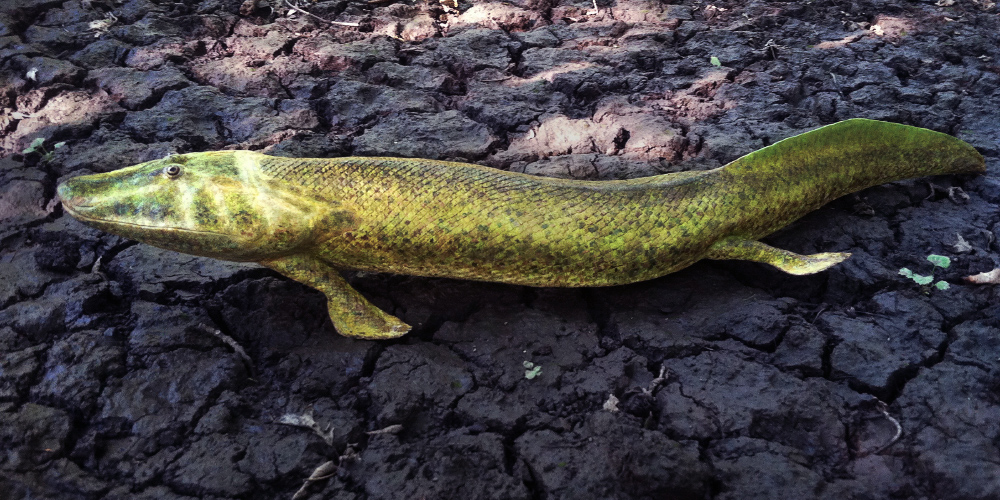
A model of Tiktaalik roseae, a 375-million-year-old transitional fossil that had a neck — unheard of for a fish — and both lungs and gills.
“Both approaches bring something unique, so they should go hand in hand,” Schmitz said. “If I had done the [eye socket size] analysis just by itself, I would be lacking what it could actually mean. Eyes do get bigger, but why?” Sensory modeling can answer this kind of question in a quantitative, rather than qualitative, way.
Schmitz plans to examine other water-to-land transitions in the fossil record — not just that of the early tetrapods — to see if he can find a corresponding increase in eye size. “If you look at other transitions between water and land, and land back to water, you see similar patterns that would potentially corroborate this hypothesis,” he said. For example, the fossil record for marine reptiles, which rely heavily on vision, should also show evidence for an increase in eye socket size as they moved from water to land.
New Ways of Thinking
MacIver’s background as a neuroscientist inevitably led him to ponder how all this might have influenced the behavior and cognition of tetrapods during the water-to-land transition. For instance, if you live and hunt in the water, your limited vision range — roughly one body length ahead — means you operate primarily in what MacIver terms the “reactive mode”: You have just a few milliseconds (equivalent to a few cycle times of a neuron in the brain) to react. “Everything is coming at you in a just-in-time fashion,” he said. “You can either eat or be eaten, and you’d better make that decision quickly.”
But for a land-based animal, being able to see farther means you have much more time to assess the situation and strategize to choose the best course of action, whether you are predator or prey. According to MacIver, it’s likely the first land animals started out hunting for land-based prey reactively, but over time, those that could move beyond reactive mode and think strategically would have had a greater evolutionary advantage. “Now you need to contemplate multiple futures and quickly decide between them,” MacIver said. “That’s mental time travel, or prospective cognition, and it’s a really important feature of our own cognitive abilities.”
That said, other senses also likely played a role in the development of more advanced cognition. “It’s extremely interesting, but I don’t think the ability to plan suddenly arose only with vision,” said Barbara Finlay, an evolutionary neuroscientist at Cornell University. As an example, she pointed to how salmon rely on olfactory pathways to migrate upstream.
Hutchinson agrees that it would be useful to consider how the many sensory changes over that critical transition period fit together, rather than studying vision alone. For instance, “we know smell and taste were originally coupled in the aquatic environment and then became separated,” he said. “Whereas hearing changed a lot from the aquatic to the terrestrial environment with the evolution of a proper external ear and other features.”
The work has implications for the future evolution of human cognition. Perhaps one day we will be able to take the next evolutionary leap by overcoming what MacIver jokingly calls the “paleoneurobiology of human stupidity.” Human beings can grasp the ramifications of short-term threats, but long-term planning — such as mitigating the effects of climate change — is more difficult for us to process. “Maybe some of our limitations in strategic thinking come back to the way in which different environments favor the ability to plan,” he said. “We can’t think on geologic time scales.” He hopes this kind of work with the fossil record can help identify our own cognitive blind spots. “If we can do that, we can think about ways of getting around those blind spots.”





